The Detection of Thread Roll’s Margin Based on Computer Vision
Abstract
:1. Introduction
2. Related Works
2.1. Electronic Sensors
2.2. Computer Vision
3. Preparations
3.1. Getting Thread Roll’s Coordinates in Image
- Transform the raw image into a grayscale image;
- Design two circle-filters according to the bobbin’s features [13], and . The designing principles are that the convolution between the image and filter is zero when the image only has one color or has no change in gradient. For example, in Figure 2a,b are two circle-filters designed to detect a bobbin with a seven-pixel diameter in the image;
- Use an AND operation to process the corresponding pixel value of the X-image and Y-image to obtain the AND image, as shown in Figure 3.
- We use the threshold function in opencv to process the AND image and then obtain a binary image. Next, we use a morphological filter to process the binary image to eliminate the noise, as shown in Figure 3e.
- We extract contours from the filter image, and the contour’s center is the center of the bobbin. The results are drawn in Figure 3f,g.
3.2. Perspective Transformation of Image
- Calculate the vertex coordinates of the ellipse in the raw image, which is shown in Figure 4c;
- The end face of bobbin is a circle, and its diameter in the transformed image is the major axis of the ellipse. As such, we can calculate the corresponding coordinates of four vertexes in theory, which is shown in Figure 4c;
- Establish the conversion relationship between pixel size and real size via the bobbin’s pixel diameter and real diameter.
4. Proposed Methods
4.1. Thread Roll’s Margin Detection by Contours
4.1.1. Image Process
4.1.2. Contours Extracting and Processing
- Calculate the distance between two adjacent points, as shown in Equation (4);
- If , insert points between the and +1 point, then calculate the equation of the line between the two points; the line’s equation is Equation (5).
- Calculating the number of points to insert: , then calculate the coordinates of the inserted points by Equation (6).
- The general equation of ellipse is as shown in Equation (7). Then, we obtain Equation (8) by putting the coordinates of points into Equation (7). Equation (7) can be written as Y = QM, Thus, we can obtain matrix Q from Equation (8). Then, calculate the parameters of the ellipse by Equation (9) [20], as shown in Figure 7a.
- Error calculation. We calculate the average fitting error; that is, we calculate the average distance from the contour points to the edge of ellipse, as shown in Figure 7b. We suppose the coordinate of the contour point is . Then, we connect and the center of the ellipse. The intersection point of the line and the ellipse is , then is the absolute value of the distance between and , as shown in Equations (10) and (11). The average fitting error of ellipse is defined as Equation (12), where n is the number of points used for fitting;
- Lastly we calculate the coincidence degree. The coincidence degree is defined as Equation (13). It refers to the ratio between the number of fitted points and the circumference of the ellipse;
- Merge all points sets into one set;
- Using the first 10 points to fit ellipse, if the fitting error is small, add the next point to fit the ellipse until the fitting error is greater than a certain number. Then, we add these points into a new set, as shown in Figure 7c;
- Merge a different new set to fit the ellipse; if the fitting error is small, repeat the above step. We suppose these ellipses are a bobbin or thread roll;
4.1.3. Calculate Thread Roll’s Margin
4.2. Thread Roll’s Margin Detection by Deep Learning
4.2.1. Sample Selection and Processing
4.2.2. Construction of Network
4.2.3. Model Training
4.2.4. Construction of Model Two
4.3. Fusing Detection Results
- If both results of the thread roll’s margin are zero, the thread roll’s margin is considered to be zero;
- If the results of both methods are not zero, the results need to be fused by Equation (18), where value1 is the thread roll’s margin detected based on detecting contours, value2 is the margin calculated by deep learning, and 150 is the maximum thread roll margin.
4.4. Estimate the Thread Roll‘s Margin
5. Experimental Results
5.1. Thread Roll‘s Margin Detected by Method One
5.2. Thread Roll‘s Margin Detected by Method Two
5.3. Fusing the above Two Results as Measured Value
5.4. Fusing Measured Value and Estimated Value by Kalman Filter
- The false detections are eliminated completely;
- Compared with the above value, the accuracy is improved a lot; the average error is less than 5.7 mm;
- The thread consumption speed is not a constant value, so the estimated value may have a large deviation compared with the real value.
6. Conclusions and Discussion
6.1. Conclusions
6.2. Limination
6.3. Discussion
- Detect the edge of bobbin;
- Select a small rectangular area around the bobbin edge to calculate its gray value and grayscale histogram, and then move the small rectangle farther away from the bobbin and calculate its gray value and grayscale histogram, as shown in Figure 15a,b.
- We judge whether the red rectangle is in the edge of thread roll according to the gray value and grayscale histogram.
Author Contributions
Funding
Institutional Review Board Statement
Informed Consent Statement
Conflicts of Interest
References
- Meiyan, W. The rise of labor cost and the fall of labor input: Has China reached Lewis turning point. China Econ. J. 2010, 3, 137–153. [Google Scholar] [CrossRef]
- Wang, J. The Foundation of the Intellectualization of the Textile Accessories and Parts Including On-line Detection of Textile Production Process, Quality Data Mining and Process Parameters Optimization. Text. Accessories 2018, 5, 1–3. [Google Scholar]
- Pierleoni, P.; Belli, A.; Palma, L.; Palmucci, M.; Sabbatini, L. A Machine Vision System for Manual Assembly Line Monitoring. In Proceedings of the 2020 International Conference on Intelligent Engineering and Management (ICIEM), London, UK, 17–19 June 2020. [Google Scholar]
- Chen, Z.; Shi, Y.P.; Ji, S. Improved image threshold segmentation algorithm based on OTSU method. Laser Infrared 2012, 5, 584–588. [Google Scholar]
- Imae, M.; Iwade, T.; Shintani, Y. Method for Monitoring Yarn Tension in Yarn Manufacturing Process. U.S. Patent 6,014,104, 11 January 2000. [Google Scholar]
- Catarino, A.; Rocha, A.M.; Monteiro, J. Monitoring Knitting Process through Yarn Input Tension: New Developments. In Proceedings of the IECON 02 Industrial Electronics Society, IEEE 2002 28th Annual Conference, Seville, Spain, 5–8 November 2002. [Google Scholar]
- Miao, Y.; Meng, X.; Xia, G.; Wang, Q.; Zhang, H. Research and development of non-contact yarn tension monitoring system. Wool Text. J. 2020, 48, 76–81. [Google Scholar]
- Huang, S.; Zhao, L.; Zhang, S.; Yao, G. Design and modification of a new type of yarn linear density detecting device. Shanghai Text. Sci. Technol. 2019, 9, 53–54. [Google Scholar]
- Li, J.; Li, J.; Duan, Y.; Ren, G.; Shi, W. Pipe Yarn and Color Detection Based on Deep Learning. Comput. Syst. Appl. 2021, 6, 311–315. [Google Scholar]
- Yang, Y.; Ma, X.; He, Z.; Gao, M. A Robust Detection Method of Yarn Residue for Automatic Bobbin Management System. In Proceedings of the 2019 IEEE/ASME International Conference on Advanced Intelligent Mechatronics (AIM), Hong Kong, China, 8–12 July 2019. [Google Scholar]
- Hwa, S.; Bade, A.; Hijazi, M. Enhanced Canny Edge Detection for Covid-19 and Pneumonia X-ray Images. IOP Conf. Ser. Mater. Sci. Eng. 2020, 979, 012016. [Google Scholar] [CrossRef]
- Zheng, Z.; Zha, B.; Yuan, H.; Xuchen, Y.; Gao, Y.; Zhang, H. Adaptive Edge Detection Algorithm based on Improved Grey Prediction Model. IEEE Access 2020, 8, 102165–102176. [Google Scholar] [CrossRef]
- Kivinen, J.; Smola, A.J.; Williamson, R.C. Learning with Kernels. IEEE Trans. Signal Process. 2004, 52, 2165–2176. [Google Scholar]
- Wu, L.; Shang, Q.; Sun, Y.; Bai, X. A self-adaptive correction method for perspective distortions of image. Front. Comput. Sci. China 2019, 13, 588–598. [Google Scholar] [CrossRef]
- Shi, T.; Kong, J.; Wang, X.; Liu, Z.; Zheng, G. Improved Sobel algorithm for defect detection of rail surfaces with enhanced efficiency and accuracy. J. Cent. South Univ. 2016, 23, 2867–2875. [Google Scholar] [CrossRef]
- Abolghasemi, V.; Ahmadyfard, A. An Edge-Based Color-Aided Method for License Plate Detection. Image Vis. Calc. 2009, 8, 1134–1142. [Google Scholar] [CrossRef]
- Phan, R.; Androutsos, D. Content-Based Retrieval of Logo and Trademarks in Unconstrained Color Image Databases Using Color Edge Gradient Co-Occurrence Histograms. Comput. Vis. Image Underst. 2020, 114, 66–84. [Google Scholar] [CrossRef]
- Chan, T.; Zhang, J.; Pu, J.; Huang, H. Neighbor Embedding Based Super-Resolution Algorithm through Edge Detection and Feature Selection. Pattern Recognit. Lett. 2019, 30, 494–502. [Google Scholar] [CrossRef]
- Trahanias, P.E.; Venetsanopoulos, A.N. Color Edge Detection Using Vector Order Statistics. IEEE Trans. Image Process. 1993, 2, 259–264. [Google Scholar] [CrossRef]
- Liu, Z. Construction and verification of color fundus image retinal vessels segmentation algorithm under BP neural network. J. Supercomput. 2021, 77, 7171–7183. [Google Scholar] [CrossRef]
- Spiesman, B.J.; Gratton, C.; Hatfield, R.G.; Hsu, W.H.; Jepsen, S.; McCornack, B.; Patel, K.; Wang, G. Assessing the potential for deep learning and computer vision to identify bumble bee species from images. Sci. Rep. 2021, 11, 1–10. [Google Scholar]
- Chen, W.; Yu, C.; Tu, C.; Tu, C.; Lyu, Z.; Tang, J.; Ou, S.; Fu, Y.; Xue, Z. A Survey on Hand Pose Estimation with Wearable Sensors and Computer-Vision-Based Methods. Sensors 2020, 20, 1074. [Google Scholar] [CrossRef] [Green Version]
- Lin, H.; Liang, S.; Chen, Y. Robotic Grasping with Multi-View Image Acquisition and Model-Based Pose Estimation. IEEE Sens. J. 2020, 21, 11870–11878. [Google Scholar]
- Liu, G.; Li, Z.; Zhang, L.; Xu, Y. Image Retrieval Based on Micro-Structure Descriptor. Pattern Recognit. 2019, 44, 2123–2133. [Google Scholar] [CrossRef] [Green Version]
- Tassinari, P.; Bovo, M.; Benni, S.; Franzoni, S.; Poggi, M.; Mammi, L.M.E.; Mattoccia, S.; Di Stefano, L.; Bonora, F.; Barbaresi, A.; et al. A computer vision approach based on deep learning for the detection of dairy cows in free stall barn. Comput. Electron. Agric. 2021, 182, 106030. [Google Scholar] [CrossRef]
- Yan, S.; Xiong, Y.; Lin, D. Spatial Temporal Graph Convolutional Networks for Skeleton-Based Action Recognition. arXiv 2018, arXiv:1801.07455. [Google Scholar]
- Jia, J.G.; Zhou, Y.F.; Hao, X.W.; Li, F.; Desrosiers, C.; Zhang, C.M. Two-Stream Temporal Convolutional Networks for Skeleton Based Human Action Recognition. J. Comput. Sci. Technol. 2020, 35, 538–550. [Google Scholar] [CrossRef]
- Lea, C.; Flynn, M.D.; Vidal, R.; Reiter, A.; Hager, G.D. Temporal convolutional networks for action segmentation and detection. In Proceedings of the IEEE Conference on Computer Vision and Pattern Recognition, Honolulu, HI, USA, 22–25 July 2017; pp. 156–165. [Google Scholar]
- Bernal, J.; Valverde, S.; Kushibar, K.; Cabezas, M.; Oliver, A.; Lladó, X.; The Alzheimer’s Disease Neuroimaging Initiative. Generating Longitudinal Atrophy Evaluation Datasets on Brain Magnetic Resonance Images Using Convolutional Neural Networks and Segmentation Priors. Neuroinformatics 2021, 19, 477–492. [Google Scholar] [CrossRef] [PubMed]
- Li, W.; Zhang, X.; Peng, Y.; Dong, M. Spatiotemporal Fusion of Remote Sensing Images using a Convolutional Neural Network with Attention and Multiscale Mechanisms. Int. J. Remote Sens. 2021, 42, 1973–1993. [Google Scholar] [CrossRef]
- Haenssle, H.A.; Winkler, J.K.; Fink, C.; Toberer, F.; Enk, A.; Stolz, W.; Deinlein, T.; Hofmann-Wellenhof, R.; Kittler, H.; Tschandl, P.; et al. Skin lesions of face and scalp—Classification by a market-approved convolutional neural network in comparison with 64 dermatologists. Eur. J. Cancer 2021, 144, 192–199. [Google Scholar] [CrossRef]
- Voulodimos, A.; Doulamis, N.; Doulamis, A.; Protopapadakis, E. Deep learning for computer vision: A brief review. Comput. Intell. Neurosci. 2018, 2018, 7068349. [Google Scholar] [CrossRef]
- Guo, Y.; Liu, Y.; Oerlemans, A.; Lao, S.; Wu, S.; Lew, M.S. Deep learning for visual understanding: A review. Neurocomputing 2016, 187, 27–48. [Google Scholar] [CrossRef]
- Liu, C.; Shui, P.; Wei, G.; Li, L. Modified unscented Kalman filter using modified filter gain and variance scale factor for highly maneuvering target tracking. Syst. Eng. Electron. 2014, 25, 380–385. [Google Scholar] [CrossRef]
- Arulampalam, M.S.; Maskell, S.; Gordon, N.; Clapp, T. A Tutorial on Particle Filters for Online Nonlinear/Non-Gaussian Bayesian Tracking. IEEE Trans. Signal Process. A Publ. IEEE Signal Process. Soc. 2002, 50, 174–188. [Google Scholar] [CrossRef] [Green Version]
- Lu, F.; Wang, Y.; Huang, J.; Huang, Y.; Qiu, X. Fusing Unscented Kalman filter for performance monitoring and fault accommodation in gas turbine. Proc. Inst. Mech. Eng. Part G J. Aerosp. Eng. 2018, 232, 556–570. [Google Scholar] [CrossRef]
- Togni, S.; Nikolaidis, T.; Sampath, S. A combined technique of Kalman filter, artificial neural network and fuzzy logic for gas turbines and signal fault isolation. Chin. J. Aeronaut. 2021, 34, 124–135. [Google Scholar] [CrossRef]
- Sun, X.; Wen, C.; Wen, T. High-Order Extended Kalman Filter Design for a Class of Complex Dynamic Systems with Polynomial Nonlinearities. Chin. J. Electron. 2021, 30, 508–515. [Google Scholar]
- Muhammad, W.; Ahsan, A. Airship aerodynamic model estimation using unscented Kalman filter. J. Syst. Eng. Electron. 2020, 31, 1318–1329. [Google Scholar] [CrossRef]
- Wen, C.; Wang, Z.; Hu, J.; Liu, Q.; Alsaadi, F.E. Recursive filtering for state-saturated systems with randomly occurring nonlinearities and missing measurements. Int. J. Robust Nonlinear Control. 2018, 28, 1715–1727. [Google Scholar] [CrossRef]

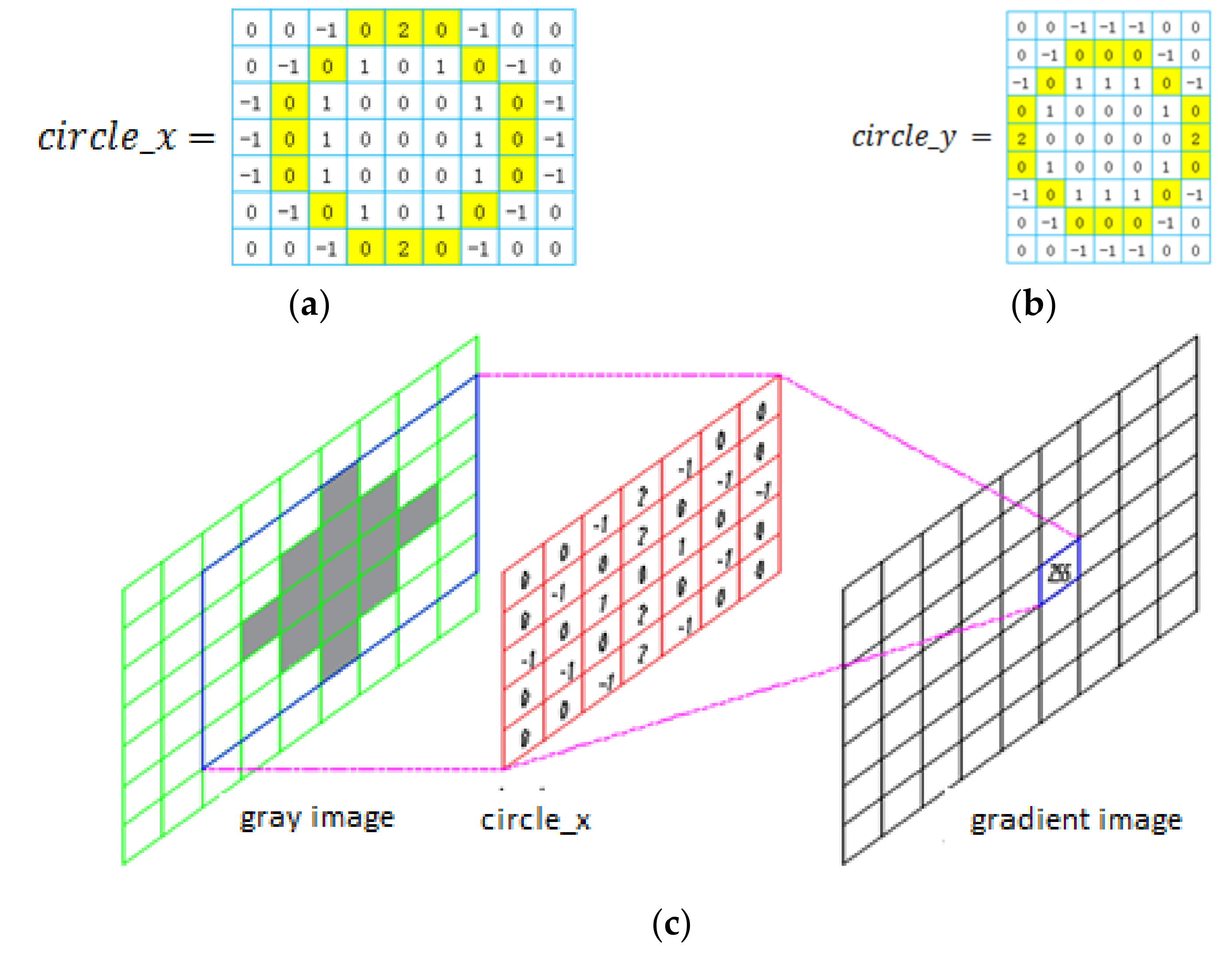
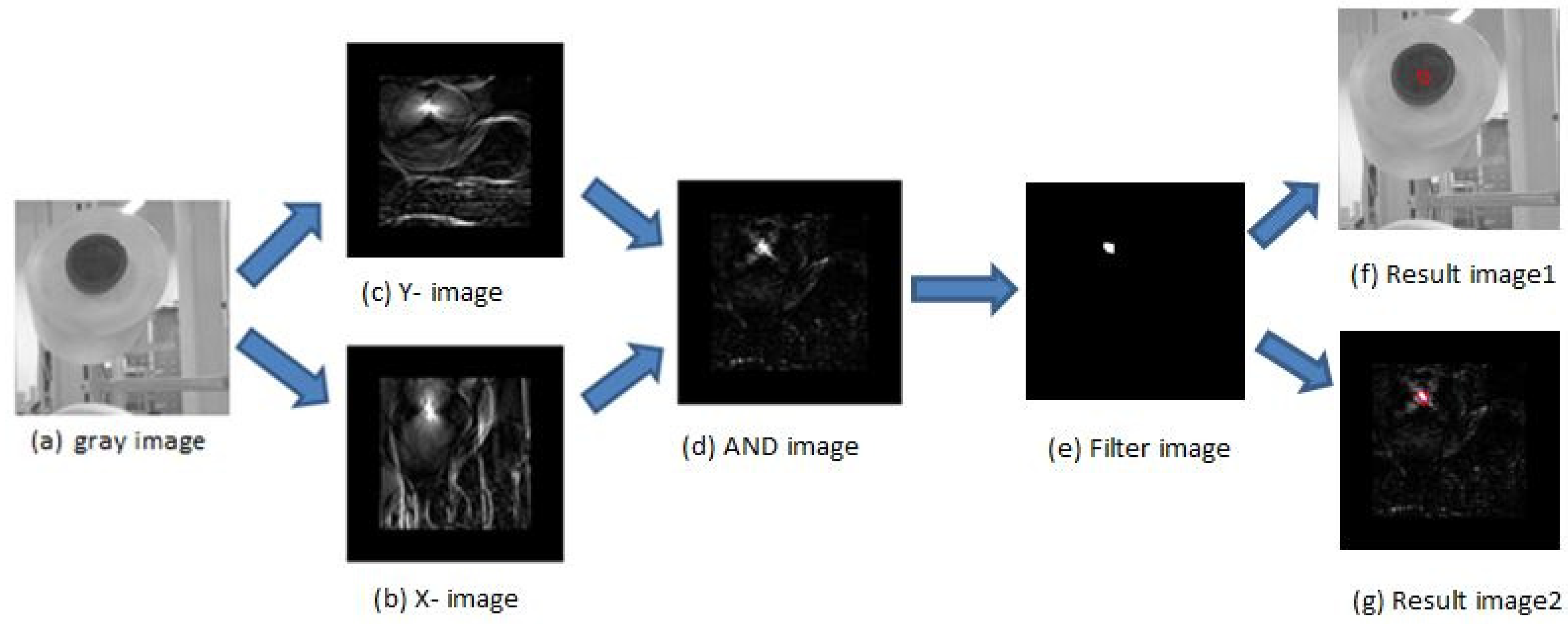
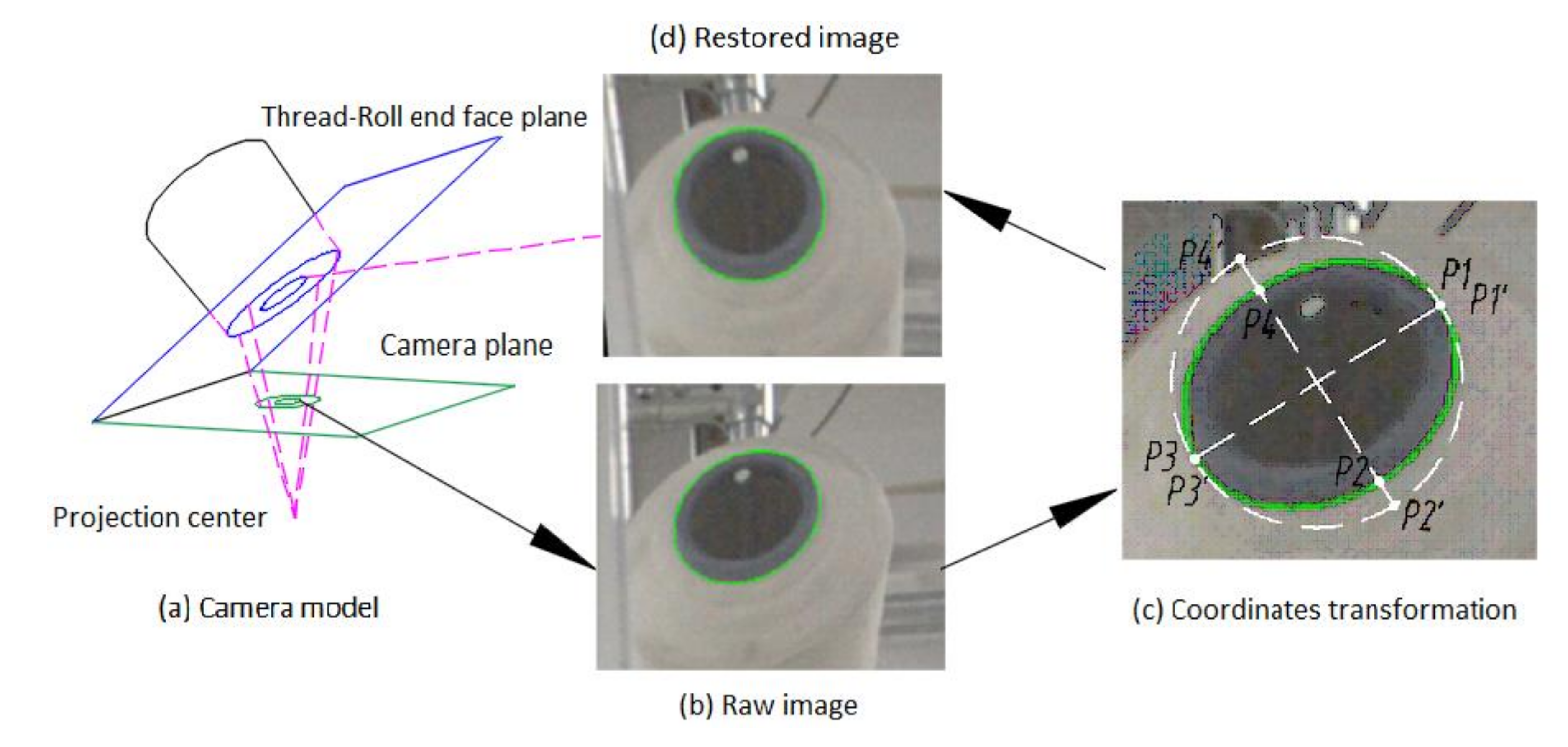
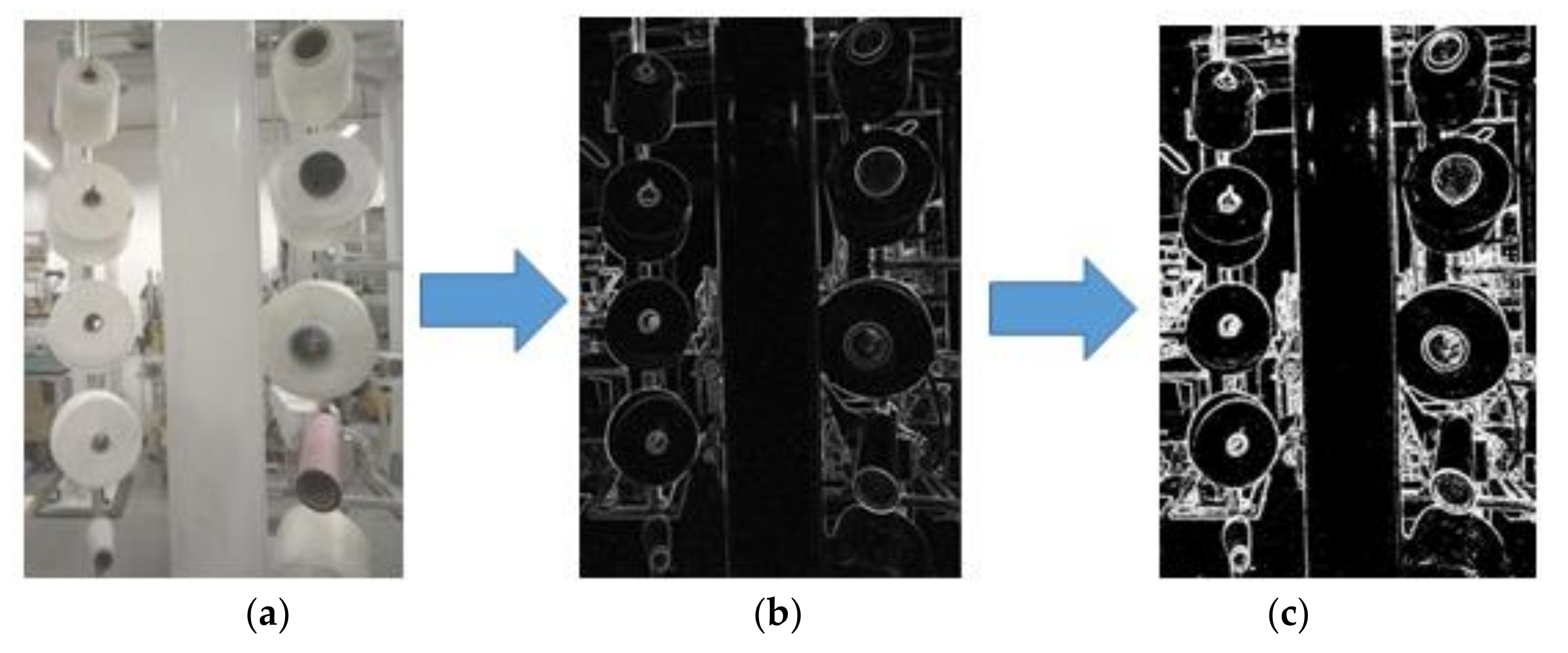




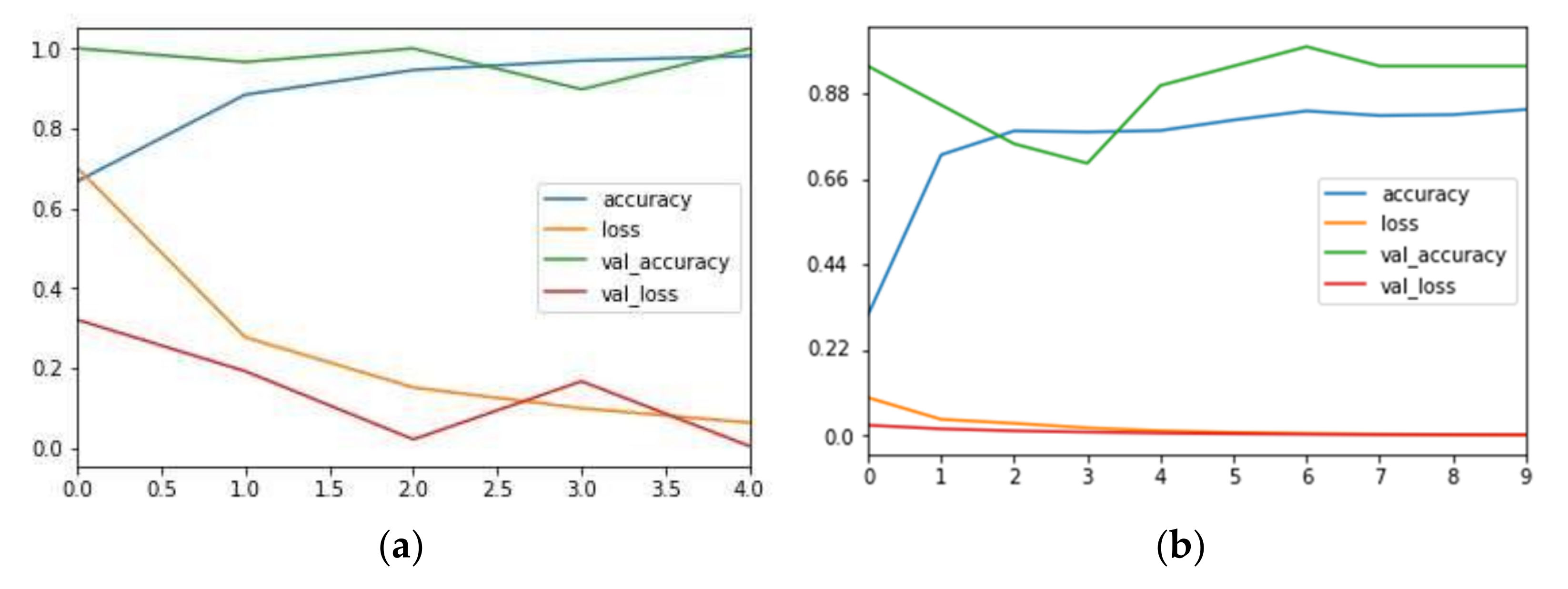

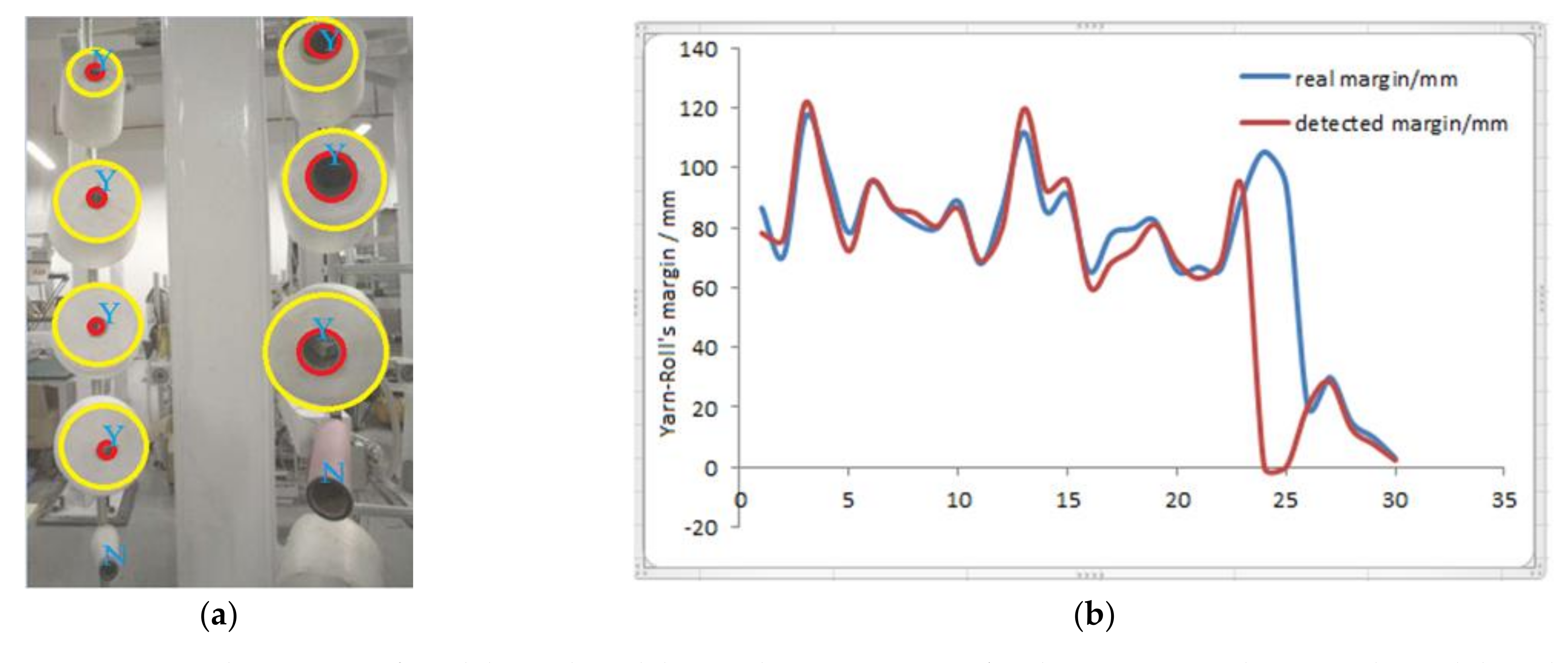
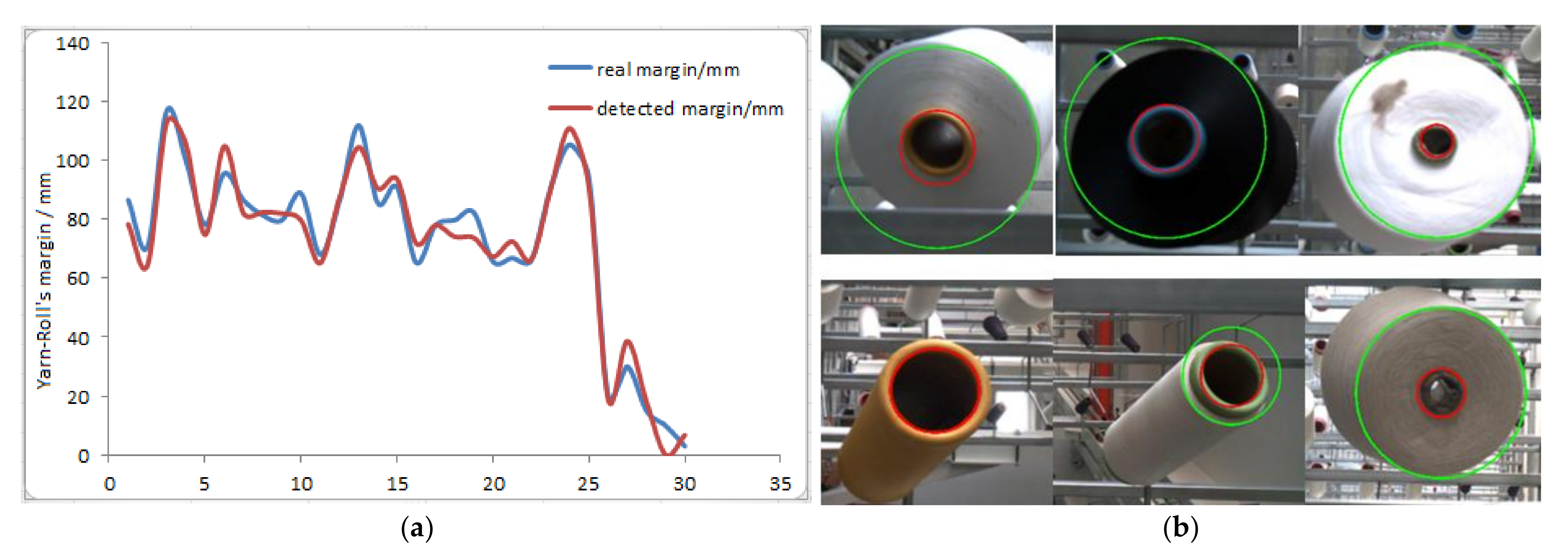


| Points Number | Points Type | Ellipse Center | Minor and Major axis | Fitting Error | Coincidence Degree |
|---|---|---|---|---|---|
| 117 | Thread Roll | (120.6, 112.5) | 44.7,55.5 | 1.03 | 0.36 |
| 121 | Bobbin | (529.2, 48.3) | 19.2, 30.1 | 0.99 | 0.74 |
| 96 | Bobbin | (144.1, 778.2) | 18.8, 23.7 | 1.15 | 0.69 |
| 214 | Thread Roll | (141.3, 777.7) | 75.5, 82.0 | 1.24 | 0.43 |
| 191 | Thread Roll | (550.8, 285.3) | 43.1, 47.6 | 1.23 | 0.66 |
| 37 | False detection | (650.0, 818.5) | 14.1, 27.3 | 2.72 | 0.26 |
| 59 | Bobbin | (525.3, 855.4) | 21.9, 26.3 | 1.35 | 0.38 |
| 140 | False detection | (127.7, 562.6) | 77.6, 82.2 | 0.98 | 0.27 |
Publisher’s Note: MDPI stays neutral with regard to jurisdictional claims in published maps and institutional affiliations. |
© 2021 by the authors. Licensee MDPI, Basel, Switzerland. This article is an open access article distributed under the terms and conditions of the Creative Commons Attribution (CC BY) license (https://creativecommons.org/licenses/by/4.0/).
Share and Cite
Shi, Z.; Shi, W.; Wang, J. The Detection of Thread Roll’s Margin Based on Computer Vision. Sensors 2021, 21, 6331. https://doi.org/10.3390/s21196331
Shi Z, Shi W, Wang J. The Detection of Thread Roll’s Margin Based on Computer Vision. Sensors. 2021; 21(19):6331. https://doi.org/10.3390/s21196331
Chicago/Turabian StyleShi, Zhiwei, Weimin Shi, and Junru Wang. 2021. "The Detection of Thread Roll’s Margin Based on Computer Vision" Sensors 21, no. 19: 6331. https://doi.org/10.3390/s21196331





